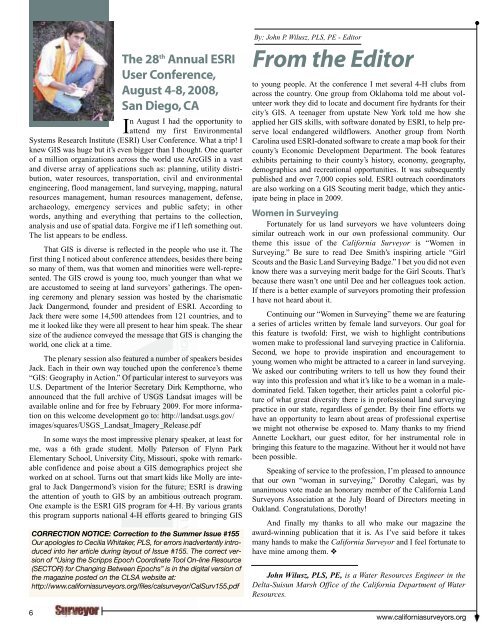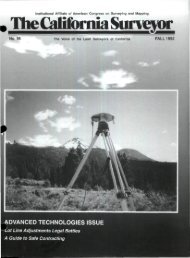CHANGE SERVICE REQUESTED The California Surveyor ... - CLSA
CHANGE SERVICE REQUESTED The California Surveyor ... - CLSA
CHANGE SERVICE REQUESTED The California Surveyor ... - CLSA
You also want an ePaper? Increase the reach of your titles
YUMPU automatically turns print PDFs into web optimized ePapers that Google loves.
In August I had the opportunity to<br />
attend my first Environmental<br />
Systems Research Institute (ESRI) User Conference. What a trip! I<br />
knew GIS was huge but it’s even bigger than I thought. One quarter<br />
of a million organizations across the world use ArcGIS in a vast<br />
and diverse array of applications such as: planning, utility distribution,<br />
water resources, transportation, civil and environmental<br />
engineering, flood management, land surveying, mapping, natural<br />
resources management, human resources management, defense,<br />
archaeology, emergency services and public safety; in other<br />
words, anything and everything that pertains to the collection,<br />
analysis and use of spatial data. Forgive me if I left something out.<br />
<strong>The</strong> list appears to be endless.<br />
That GIS is diverse is reflected in the people who use it. <strong>The</strong><br />
first thing I noticed about conference attendees, besides there being<br />
so many of them, was that women and minorities were well-represented.<br />
<strong>The</strong> GIS crowd is young too, much younger than what we<br />
are accustomed to seeing at land surveyors’ gatherings. <strong>The</strong> opening<br />
ceremony and plenary session was hosted by the charismatic<br />
Jack Dangermond, founder and president of ESRI. According to<br />
Jack there were some 14,500 attendees from 121 countries, and to<br />
me it looked like they were all present to hear him speak. <strong>The</strong> shear<br />
size of the audience conveyed the message that GIS is changing the<br />
world, one click at a time.<br />
<strong>The</strong> plenary session also featured a number of speakers besides<br />
Jack. Each in their own way touched upon the conference’s theme<br />
“GIS: Geography in Action.” Of particular interest to surveyors was<br />
U.S. Department of the Interior Secretary Dirk Kempthorne, who<br />
announced that the full archive of USGS Landsat images will be<br />
available online and for free by February 2009. For more information<br />
on this welcome development go to: http://landsat.usgs.gov/<br />
images/squares/USGS_Landsat_Imagery_Release.pdf<br />
In some ways the most impressive plenary speaker, at least for<br />
me, was a 6th grade student. Molly Paterson of Flynn Park<br />
Elementary School, University City, Missouri, spoke with remarkable<br />
confidence and poise about a GIS demographics project she<br />
worked on at school. Turns out that smart kids like Molly are integral<br />
to Jack Dangermond’s vision for the future; ESRI is drawing<br />
the attention of youth to GIS by an ambitious outreach program.<br />
One example is the ESRI GIS program for 4-H. By various grants<br />
this program supports national 4-H efforts geared to bringing GIS<br />
6<br />
<strong>The</strong> 28 th Annual ESRI<br />
User Conference,<br />
August 4-8, 2008,<br />
San Diego, CA<br />
CORRECTION NOTICE: Correction to the Summer Issue #155<br />
Our apologies to Cecilia Whitaker, PLS, for errors inadvertently introduced<br />
into her article during layout of Issue #155. <strong>The</strong> correct version<br />
of “Using the Scripps Epoch Coordinate Tool On-line Resource<br />
(SECTOR) for Changing Between Epochs” is in the digital version of<br />
the magazine posted on the <strong>CLSA</strong> website at:<br />
http://www.californiasurveyors.org/files/calsurveyor/CalSurv155.pdf<br />
By: John P. Wilusz, PLS, PE - Editor<br />
From the Editor<br />
to young people. At the conference I met several 4-H clubs from<br />
across the country. One group from Oklahoma told me about volunteer<br />
work they did to locate and document fire hydrants for their<br />
city’s GIS. A teenager from upstate New York told me how she<br />
applied her GIS skills, with software donated by ESRI, to help preserve<br />
local endangered wildflowers. Another group from North<br />
Carolina used ESRI-donated software to create a map book for their<br />
county’s Economic Development Department. <strong>The</strong> book features<br />
exhibits pertaining to their county’s history, economy, geography,<br />
demographics and recreational opportunities. It was subsequently<br />
published and over 7,000 copies sold. ESRI outreach coordinators<br />
are also working on a GIS Scouting merit badge, which they anticipate<br />
being in place in 2009.<br />
Women in Surveying<br />
Fortunately for us land surveyors we have volunteers doing<br />
similar outreach work in our own professional community. Our<br />
theme this issue of the <strong>California</strong> <strong>Surveyor</strong> is “Women in<br />
Surveying.” Be sure to read Dee Smith’s inspiring article “Girl<br />
Scouts and the Basic Land Surveying Badge.” I bet you did not even<br />
know there was a surveying merit badge for the Girl Scouts. That’s<br />
because there wasn’t one until Dee and her colleagues took action.<br />
If there is a better example of surveyors promoting their profession<br />
I have not heard about it.<br />
Continuing our “Women in Surveying” theme we are featuring<br />
a series of articles written by female land surveyors. Our goal for<br />
this feature is twofold: First, we wish to highlight contributions<br />
women make to professional land surveying practice in <strong>California</strong>.<br />
Second, we hope to provide inspiration and encouragement to<br />
young women who might be attracted to a career in land surveying.<br />
We asked our contributing writers to tell us how they found their<br />
way into this profession and what it’s like to be a woman in a maledominated<br />
field. Taken together, their articles paint a colorful picture<br />
of what great diversity there is in professional land surveying<br />
practice in our state, regardless of gender. By their fine efforts we<br />
have an opportunity to learn about areas of professional expertise<br />
we might not otherwise be exposed to. Many thanks to my friend<br />
Annette Lockhart, our guest editor, for her instrumental role in<br />
bringing this feature to the magazine. Without her it would not have<br />
been possible.<br />
Speaking of service to the profession, I’m pleased to announce<br />
that our own “woman in surveying,” Dorothy Calegari, was by<br />
unanimous vote made an honorary member of the <strong>California</strong> Land<br />
<strong>Surveyor</strong>s Association at the July Board of Directors meeting in<br />
Oakland. Congratulations, Dorothy!<br />
And finally my thanks to all who make our magazine the<br />
award-winning publication that it is. As I’ve said before it takes<br />
many hands to make the <strong>California</strong> <strong>Surveyor</strong> and I feel fortunate to<br />
have mine among them. ❖<br />
John Wilusz, PLS, PE, is a Water Resources Engineer in the<br />
Delta-Suisun Marsh Office of the <strong>California</strong> Department of Water<br />
Resources.<br />
www.californiasurveyors.org
















